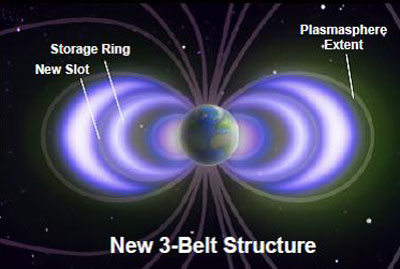page 2
Note: the contents of this page as well as those which precede and follow, must be read as a continuation and/or overlap in order that the continuity about a relationship to/with the dichotomous arrangement of the idea that one could possibly talk seriously about peace from a different perspective as well as the typical dichotomous assignment of Artificial Intelligence (such as the usage of zeros and ones used in computer programming) ... will not be lost (such as war being frequently used to describe an absence of peace and vice-versa). However, if your mind is prone to being distracted by timed or untimed commercialization (such as that seen in various types of American-based television, radio, news media and magazine publishing... not to mention the average classroom which carries over into the everyday workplace), you may be unable to sustain prolonged exposures to divergent ideas about a singular topic without becoming confused, unless the information is provided in a very simplistic manner.
Let's face it, humanity has a lousy definition, accompanying practice, and analysis of peace.
Let's look at a couple of definitions:
(1)peace \'pe-s\ n| [ME pees,| fr. AF pes, pees,| fr. L pac-, pax;| akin to L pacisci| to agree — more at pact] (12c)
1 : a state of tranquillity or quiet: as
a : freedom from civil disturbance
b : a state of security or order within a community provided for by law or custom ‹a breach of the (peace)›
2 : freedom from disquieting or oppressive thoughts or emotions
3 : harmony in personal relations
4 a : a state or period of mutual concord between governments
b : a pact or agreement to end hostilities between those who have been at war or in a state of enmity
5 — used interjectionally to ask for silence or calm or as a greeting or farewell
— at peace : in a state of concord or tranquillity
(2)peace vi| (14c) obs: to be, become, or keep silent or quiet
Source: Merriam-Webster's dictionary and Thesaurus
Noun: Peace ♫ pees
1. The state prevailing during the absence of war
2. Harmonious relations; freedom from disputes ("the roommates lived in peace together")
3. The absence of mental stress or anxiety
4. The general security of public places ("he was arrested for disturbing the peace")
5. A treaty to cease hostilities ("peace came on November 11th")
Derived:
Verb- pacify
Adjective- peaceful
Source: Wordweb dictionary
As noted in the previous page, the definition of peace generally revolves around an absence of war, though as can be seen in the above two examples, different words can be used to illustrate this main theme. There is no inclination to specifically define peace as an absence of hunger, homelessness, ill-health, joblessness, high medical costs, high food costs, excesses of salt, fat, coloring, etc. in foodstuffs, crime, exploitation (such as from businesses, governments and religions), lack of an Actual Democracy, and various other recurring social concerns.
The definitions employed are particularly limited and limiting. If we continue to describe peace in the same fashion, our ability to be more expansive in our thinking and resulting actions will be severely restricted. Although the word "Peace" often is aligned with the notion of pacifism and pacifists, the word "conservative" nor "conservatism" are viewed as attributes... even though they are. In other words, the rather limited way in which the word peace is defined portrays an unrealized expression of an underlying conserved mental construct... or if you prefer, "pattern".
In an analysis of language it is necessary for us to take a look at the mechanism of hearing since an observation of deaf persons reveals the important role that hearing plays:
|
| |
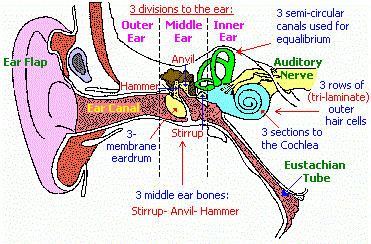 | |
| 3 overall divisions: | Outer ear~ Inner ear~ Middle ear |
| 3 middle ear divisions: | Tympanum~ Epitympanum~ Mastoid antrum |
| 3 eardrum membranes: | Cutaneum~ Collagen fibers~ Mucosm |
| 3 semi-circular canals: | Used for balance (equilibrium) |
| 3 bones: | (ossicular chain) Incus~ Stapes~ Malleus |
| 3 main malleus ligaments: | Anterior~ Lateral~ Superior |
| 3 incus anchorage points: | Malleus~ Stapes~ Bony fossa wall |
| 3 cochlea sections: | (Scala) Vestibuli~ Tympani~ Cochlear duct |
| 3 extrinsic muscles (Auricularis): | Anterior~ Superior~ Posterior |
| 3 sound conduction paths: | Electrical~ Mechanical~ Fluid or: Bone (solid)~ Air (gas)~ Fluid (liquid) |
| 3 nerve stimulation paths: | Mechanical~ Chemical~ Electrical |
| 3 outer hair cell rows |
typical in mammals but some sources give 3, 4, or 5 |
| Neurotrophin-3 (NT-3) is synthesized by inner and outer hair cells of the developing organ of Corti. | Brain-derived neurotrophic factor (BDNF) is also synthesized. (Prestin is the motor protein of the outer hair cells.) |
| 3 sound qualities: | Pitch~ Volume (intensity)~ Tone |
| 3 sound wave propagation processes: | Diffraction~ Transmission~ Reflection |
| 3 main forms of ossicular chain fixation: | Fluid~ Mechanical~ Otosclerosis |
| 3 classes of ossicular lever action: | Force arm~ Resistance arm~ Fulcrum |
| 3 acoustic distortion forms: | Frequency~ Phase~ Amplitude |
| 3 basic properties of vibrating bodies: | Inertia~ Elasticity~ Dissipation |
| 3 principal types of deafness: | Conduction~ Nerve~Stimulation |
| 3 types of hearing loss: | Conductive~ Sensorineural~ Mixed |
| 3 (inner ear) organs of balance: | Semicircular canals~ Utricle~ Saccule (collectively called the vestibular organ, which can be referred to as a {3-in-1} ratio.) |
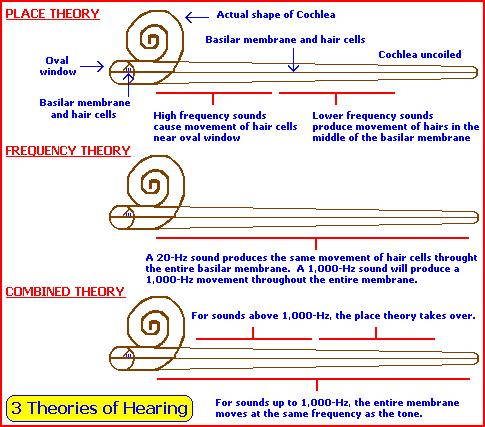
3 turns to the Cochlea, but variously mismeasured (?) as the following examples portray, or suggesting further evolutionary growth is to come?:
- 2 3/8 turns
- 2 1/4turns
- 2 1/2 turns
- 2 5/8 turns
- 2 3/4 turns
- 2 7/8 turns
- etc., ???
*** Imagine our language development if our ear components exhibited a different predominant pattern: 2, 4, 5, 6, 7, 8, 9, 13, 40, etc...
Three major, at least partially overlapping Ear development processes:
- Morphogenesis transforms the otocyst into a complex three-dimensional structure.
- Cell fate determination turns the uniform columnar epithelial cells of the otocyst into sensory neurons, hair cells and various kinds of supporting cells.
- Proliferation expands the microscopically small sheet of the otic placode cells into a system of several thousand cells that is several millimeters large.
http://www.biomedsci.creighton.edu/faculty/fritzsch.html
And as already noted, the "three" can be accompanied by patterns-of-two, such as the following example:
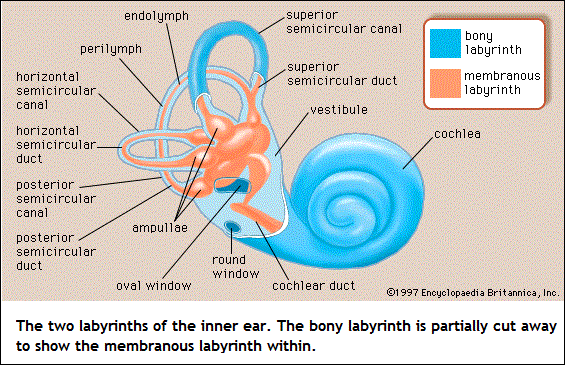
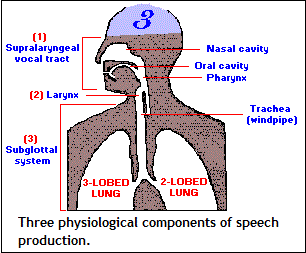
And with hearing, comes language. Imagine what our language would be like if there was some other dominant pattern. Let us begin by saying that many people hold a pen or pencil with three fingers in their effort to portray symbols of the alphabet into words, then into sentence structures, and then paragraphs. With respect to language, all languages are said to comprise a Subject, Object, and Verb, though not necessarily in this order. It is referred to as the Trimodal structure of language. And no matter what language we are talking about, all of them use three types of sentence-ending punctuations called the Period, Question Mark, Exclamation Point.
Stark & Nathanson (1973) differentiated three types of infant vocalizations:
- Cry sounds (sounds produced in acute stress such as pain or hunger)
- Discomfort sounds (a lesser degree of discomfort such as when not reaching a toy)
- Vegetative sounds (coughs, burps, sneezes)
Wolff (1965) described three cry types:
- Basic cry
- Mad/Angry cry
- Pain cry
Truby & Lind (1965) referred to three acoustic types of cry:
- Phonation (basic cry)
- Dysphonation (turbulence)
- Hyperphonation (shift)
3 successive/overlapping stages of infant babbling (there are a variety of sounds):
- Single Chunks (Ba)
- Double chunks (MaMa)
- Triple Chunks (DaDaDa)... (combinations of any of the three can produce long strings of utterances called "reduplications")
3 successive/overlapping stages of word development (such as for example):
- Single word (Doggie)
- Double word (Doggie Come)
- Triple word (Doggie Come Here)... (combinations can produce the proverbial and jocular denotation referred to as yakety-yak-yak)
"Primitive" speakers such as the old Tarzan (Johnny Weissmuller) and Native Americans as portrayed in motion pictures, frequently used 1, 2, or 3- word expressions.

Apes that learn to sign, learn the vocabulary of three-year old humans.
The lion in the MGM motion picture logo (for Metro-Goldwynn-Mayer) had, over the years, displayed a lion roaring once or twice or thrice.

- 3 Esophagus parts: Pars Cervicalis - Pars Thoracica - Pars Abdominalis
- 3 single and 3 pairs of cartilage compose the frame (skeleton) of the larynx
- 3 basic parts to all languages: Subject - Object - Verb
- 3-model structure of all languages: Phonology - Grammar - Lexicon
3 Noam Chomsky transformational grammar components: Phrase-structure - Transformational - Morphophonemic
3 founding themes of generative grammar: Mentalism- Combinatoriality- Acquisition 3 major stages of Chomskyan syntactic theory: (1) The Aspects theory. (2) Principles and Parameters (or Government-Binding) Theory (Chomsky 1981). (3) The Minimalist Program (Chomsky 1995).3 major stages of Chomskyan syntactic theory- architecture of components:
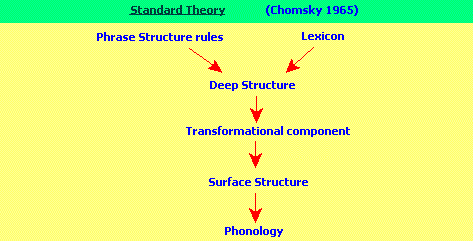 |
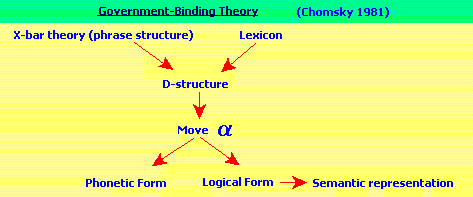 |
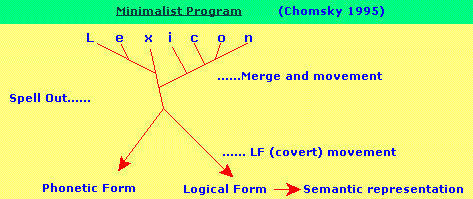 |
3 parts to speech: Consonants - Vowels - Supra-segmentals
3 stress forms in language: Primary - Secondary - Weak
3 English Language divisions: Old - Middle - Modern
3 Archaic Chinese Language divisions: Early - Middle - Late
3 sentence Types: Simple - Compound - Complex
3 library researches: Author - Title - Subject
3 word variation categories: Antonyms - Homonyms - Synonyms
3 types of Verbals (special forms of a verb): Gerund - Infinitive - Participle
3 successive stages of writing development: Logography - Syllabography - Alphabetography
3 great writing steps: Sumerian phonetization - West Semitic syllabary - Greek alphabet
3 writing systems on 3 Mayan Codices: Dresden Codex - Madrid Codex - Paris Codex
3 languages on Sumerian Cuneiform: Semitic Babylonian - Indo-European Persian - Elamite
3 different historical relics with three-language inscriptions:
- Rosetta Stone: Hieroglyphics - Demotic Script - Greek
- Behistun Rock: Old Persian, Akkadian (or Babylonian), and Elamite
- Galle Tablet: Chinese, Tamil and Persian
3 Types of Languages (Isadore of Seville, 7th Century A.D.):
- All the Oriental nations jam tongue and words together in the throat, like Hebrews and Syrians.
- All the Mediterranean peoples push their enunciation forward to the palate, like the Greeks and the Asians.
- All the Occidentals break their words on the teeth, like the Italians and Spaniards.
3 rulers are noted for carrying out experiments (by isolating children from all spoken language influences) to determine which language would be spoken first, and hence, identify the first language:
- Egyptian Pharaoh Psammetichus (664 - 610 B.C.)
- James IV of Scotland (A.D. 1473 - 1513)
- Roman Emperor Fredrick II of Hohenstaufen (A.D. 1200's).
The "Three Languages" story occurring in Fairy tales is said to be very old and exist in various versions in different cultures.
3 allophone (phonemic derivative) environments:
- At the end of a word (only oral vowels; no nasal vowels)
- Before nasal consonants (only nasalized vowels; no oral vowels)
- Before non-nasal consonants (only oral vowels; no nasalized vowels)
3 types of alphabet in use characterized by 3 different methods of indicating vowels:
- Greek, Latin, and so on - vowels indicated by separate signs
- Aramaic, Hebrew - Arabic, and so on - vowels indicated by separate diacritic marks
- Ethiopic, Indic - vowels indicated by diacritic marks attached to the sign or, very rarely, by internal modification.
3 (talking) drills: Imitation - Substitution - Transformational (Guided repetition to instill a particular aspect of language in a learner)
3 types of syllable stress by Sebastian Shaumyan (1987): Strong/Dynamic - Quantitative - Tonal/Musical
Tripartite division of language classification by the Linguist August Schleicher: Isolating - Agglutinating - Inflecting. [Influenced by Darwin, he proposed that his three types represent different stages in the evolution of languages. He made an attempt to support his views by using analogies to nature: Isolating (crystals) - Agglutinating (plants) - Inflecting (animals).]
Is the usage of a "three" formula a coincidence, or does it reveal an environmentally influenced effect that forces us to be conserved in our physiology and mentality because it is a survival mechanism suited to adapt to changing conditions headed along a course of decay... in an effort to maintain some semblance of equilibrium that involves various forms of rationalization which can be quite elaborate in terms of established or establishing an adhering belief system? Such as for example, the usage of the "Trinity" in (Later) Christian theology, the Trimurti (of Later) Hinduism, the "AUM" (Om) chant of some meditations, and the three branches of government (Executive- Legislative- Judicial) in the (later European-derived) U.S., and the (later originating) Tripartite social stratification (Priestly class- Warrior class- Worker class) of Indo-Europeans and those they influenced (such as Buryat Mongols whose earlier traditional social stratification consisted of noble and common strata; but whose matrilineal families were grouped into kin villages, clans, and clan confederations).

Om, in Hinduism and other religions chiefly of India, a sacred syllable that is considered to be the greatest of all the mantras, or sacred formulas. The symbol Om is composed of the three sounds a-u-m (in Sanskrit, the vowels a and u coalesce to become o), which represent several important triads: the three worlds of earth, atmosphere, and heaven; the three major Hindu gods, Brahma, Vishnu, and Siva; and the three sacred Vedic scriptures, Rg, Yajur, and Soma. Thus Om mystically embodies the essence of the entire universe. It is uttered at the beginning and end of Hindu prayers, chants, and meditations and is freely used in Buddhist and Jaina ritual also. From the 6th century, the written symbol designating the sound is used to mark the beginning of a text in a manuscript or an inscription. The syllable is discussed in a number of the Upanishads, which are the texts of philosophical speculation, and it forms the entire subject matter of one, the Mandukya. It is used in the practice of Yoga and is related to techniques of auditory meditation. In the Puranas the syllable is put to sectarian use; thus the Saiva mark the lingam, or sign of Siva, with the symbol for Om, whereas the Vaishnava identify the three sounds as referring to a trinity composed of Vishnu, his wife Sri, and the worshipper. |
Source for Buryat information (aside from Georges Dumezil's Tripartite Ideology Theory): "Buryat." Encyclopædia Britannica Ultimate Reference Suite, 2013.
When we teach children the alphabet, we say we are going to teach them their "ABC's", not their "ABCD's", "ABCDE's", etc... In other words, we reference it with the first three letters. When we tell children in school that there are three different grade values (A+, A, A-), what are we actually saying? When we tell them that Nouns are "Persons- Places- Things", how come we only cite three items? Let's take a look at a few other grammar profiles:
3 Tenses: Past- Present- Future
3 sentence types: Simple- Compound- Complex
3 Pronoun types: 1st person- 2nd person- 3rd person
3-part mnemonic rule: I before E except after C
3 Noun types: Person - Place - Thing
3 Pronoun types: First person - Second person - Third person
3 Personal Pronoun Cases: Subjective - Objective - Possessive
3 Personal Pronoun Genders: Masculine - Feminine - Neuter
3 Verb Inflections: Tense - Mood - Number
3 Adjective comparison degrees: Positive - Comparative - Superlative
3 Affix subdivisions: Prefixes - Infixes - Suffixes
3 basic correct punctuation units: Phrase - Independent Clause - Dependent Clause
3 Verb moods: Indicative- Imperative- Subjunctive
3 punctuation units: Phrase- Independent clause- Dependent clause
3 Verb inflections: Tense- Mood- Number
3 subordinate clauses: Adjective- Adverb- Noun
3 gender grammar: Masculine- Feminine- Neuter
3 division writing structure: Title- Body- Conclusion
3 historical writing stages: Logography- Syllabography- Alphabetography
ETC. ETC. ETC.
Again, let us review a previous comment: It is not that we are incapable of thinking in more complex patterns, it's just that there is a consistent conservation of activity taking place. This suggests there is something forcing our bodies and minds to comply as a type of necessary survival mechanism in an environmental situation that is decaying. Much in the manner that in an environment were resources are diminishing or selectively organized, the size (quantity) and quality (physical attributes such as tall, short, thin, etc...) will be brought out. However, anthropologists have not looked upon the recurring basic structural patterns of our anatomy with our basic mental patterns displayed in language as is being described herein.
If we look at language development starting with infants, since it is not likely that infants are not yet subjected to cultural influences, what we find is a recurring three-patterned developmental exercise. Past the blowing bubbles and other expressions called "vegetative" oral activity, we eventually recognize sounds referred to as Babbling. Babbling is said to consist of "chunks" variously described and written as Ba, Da, Na, Ti, etc... However, what is overlooked is that there is a transformational developmental pattern consisting of a one-chunk phase, a two-chunk phase and a three-chunk phase that is then followed by a one-word phase, a two-word phase and a three-word phase. And yes, there are variations such as some infants/children using one or another repetitive pattern and that not all may exhibit ("articulate") the pattern as it is being distinctly described here. Some may skip a phase while others linger. It matters not. What matters is that the same overall pattern is repeating at a very early developmental stage of vocalization that is repeated into adulthood with other three-patterned structures.
It is only normal and natural because of the developmental influenced imposed on humanity because of a decaying planet. Our beliefs are elaborate rationalizations to keep us attached to "mother" Earth like an invisible umbilical cord. The usage of more elaborate (and irrational) beliefs will continue to invade human consciousness the more intense the decay of the planet increases and resources are diminished. Humanity can not stop the decay. The Moon will continue to recede causing a slowing of tidal behavior (the "washing machine effect"), the Sun's energy will continue to burn out and it will enlarge in size, and the Earth's rotation will continue to slow, thus affecting the electro-magneto dynamo effect. There is nothing humanity can do about this. It is going to happen since it is already taking place. Humanity can not save the Earth. But it may be able to preserve itself if it focuses the efforts of humanity towards leaving the planet and eventually the galaxy.
Regardless of all the arguments that might be posed regarding the length of time involved with the processes of decay, the systematic deterioration will cause humanity to alter its views to correspond to further rationalizations for perpetuating life styles to coincide with an acceptance of changing conditions and deny the ensuing effects; or otherwise claim the demise as some sort of grand universal scheme, or a god's plan for some presumed glorious after-life. All such ideas are "adjustable" rationalizations meant to assist in maintaining an equilibrium in a decaying environment.
Let's now look at a compilation of various other three-patterned ideas so that you can see how "scientific" or "scientifically theoretical" it is as well, keeping in mind that the "theo" in the word "theoretical" is originally related to the "theo" in "theology":
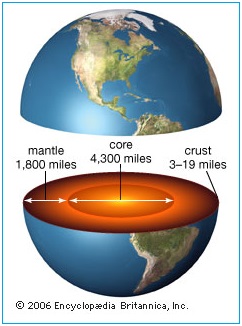 3rd planet from the Sun: Earth
3rd planet from the Sun: Earth3 basic layers to Earth: Crust~ Mantle~ Core
***Earth's shape is a triaxial ellipsoid
333,000 times that of the Earth: The Sun's "approximate" Mass
3 degrees: Temperature of Outer Space (middle point between 2.5 to 3.5 range)
3 atmospheric gas content constants on Earth: 78% Nitrogen~ 21% Oxygen~ 1% all other gases
3 theories concerning form of Universe: Flat ~ Spherical ~ Saddle Shaped (Linear~ Circular~ Triangular)
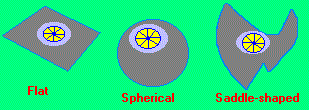
3 curvatures of the Universe: Zero (Neutral)- Positive- Negative
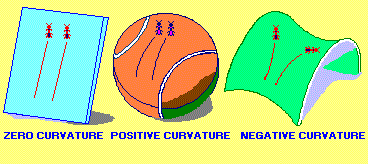
3 phenomena of Big Bang theorists: Helium abundance~ Microwave background~ Hubble expansion
3 Van Allen Radiation Belts (though typically viewed as having two belts, the third is not yet known whether it is a fluke or a recurring incident for particular circumstances. Another interpretation would be to view it as a fluctuation occurring as a result of an upcoming eventuality, like a person who transitions between adolescence and adulthood for awhile, though the "transition period" of the belts may be on the order of many, many years... or not. The "third ring" gives the sense of having to add another hole to a belt because one's waistline is expanding):
 333 miles per hour: Earth's "approximate" rate of spin where the actual spin rate is 333 X 3.123123123123123 (or, 1,040 miles per hour)
333 miles per hour: Earth's "approximate" rate of spin where the actual spin rate is 333 X 3.123123123123123 (or, 1,040 miles per hour)3 variations to Earth's rotation:
Secular (Friction from Earth's tidal bulge) ~
Periodic (Seasonal changes & regular events) ~
Irregular (Turbulent core/mantle interactions)
3 (23.5°) measurements of Earth:
(1) The Earth's axis sweeps out a cone of 23.5° half angle in 26,000 years
(2) Summer solstice from equator
(3) Winter solstice from equator
3 large planetary deteriorations:
(1) Moon is receding... causing a slowing of tidal ("washing machine") behavior.
(2) Earth's rotation is slowing... causing instability in geo-magnetism.
(3) Sun's energy is depleting... and the Sun is said to one day expand and may gobble-up the Earth.
3 families of fundamental particles: (Stable- Unstable- Highly unstable)
3 parts of an atom: Neutrons~ Protons~ Electrons
3 basic parts to fundamental parts of atoms: 3 Quarks and 3 Anti-Quarks
3 content percentages of Gunpowder: 75% Potassium nitrate~ 15% Charcoal~ 10% Sulfur
3 basic components to nitroglycerine: Glycerol~ Nitric acid~ Sulfuric acid
3-lettered explosive (TNT) Tri-nitrotoluene, is a standard by which all other explosives are measured for cost, transport, and flexibility of use.
3 land mass configurations of Earth: (One continent- Pangaea, Two continents- Laurasia and Gondwana land, Many continents... today)

3 processes of nuclear energy: Fission ~ Fusion ~ Combination(?)
3 Big Bangs:
(1) The "original" Big Bang of the Universe
(2) Mammoth explosion of a nearby massive star
(3) 65 million year old "Dinosaur killer" rock that caused a nuclear winter
***Triple alpha process occurring in the interior of stars at 100 million degrees is responsible for the nuclear formation of carbon
3 classical origin-of-Moon hypothesis:
(1) Binary planet or "sister" hypothesis~
(2) Rotational fission or "daughter" hypothesis~
(3) Capture or "wife" hypothesis
3 major (Moon) rock types: Potassium-rich basalt~ Anorthosite~ An Iron, Titanium-rich basalt
3 Universe Cosmology of J.R. Gott III: Our Universe~ Antimatter Universe~ Tachyon Universe
 3 atoms to water molecule
3 atoms to water molecule3 basic forms of Matter: Solids- Liquids- Gases
3 basic Rock forms: Igneous~ Metamorphic~ Sedimentary
3 forms of Carbon: Diamonds~ Graphite~ Fullerene
3 forms of Atomic radiation: Alpha-Beta-Gamma
3 general laws of Thermodynamics
3 laws of Planetary Motion (Johannes Kepler)
3 laws of motion (Isaac Newton)
3 basic Hydrodynamic laws
3 Magnetism "laws": Opposites attract~ Likes repel~ Inverse square
3 basic materials used in magnets: Iron~ Cobalt~ Nickel
3 millimeters thick is considered a typical magnet by some standards
3 magnetic materials: Hard~ Soft~ Semi-hard (recording materials)
***Triplets are the most commonly found phosphorescing states
3 major wavelengths of sunlight: Visible~ Ultraviolet~ Infrared
3 ultraviolet radiation divisions:
Near (4,000- 3,000 Å) ~
Middle (3,000- 2,000 Å) ~
Long (2,000- 100 Å)
3 fundamental forces of nature: Gravitational~ Nuclear (strong/weak interactions)~ Electromagnetic
3 "ideal gas" laws: Robert Boyle's~ J. Charles or J. Lussac's~ Avogadro's
(These 3 explain {in a 3 to 1 ratio way} how Pressure~ Temperature~ Volume + number of particles in a container of gas are related.)
Yes, some readers may by now be saying that they could make a list using some other number pattern... yet in so doing, they too would find that there is a conservation of number in effect. Sure, we can find a handful of this or that larger number such as 7 or 13 or 40... etc., but they will not find the same diversity of "ideological species" as a 1, 2, 3 and 3-to-1 ratio configuration. And yes, we can find examples of "5,6,7,8,9,10,11,12" etc., but we need to distinguish which are truly a separate pattern or are a multiplication of some simpler value. Again, it is not that we are incapable of seeing, thinking about or illustrating in larger patterns, it's just that it is not customary to do so. We have to think "outside the box" of the basic conventions found in our physiology... and yet may not be able to convince another or an entire culture to adopt such a perspective. Most people utilize some characteristic of a one, two, three... and three-to-one configuration, with the labels four or five or six as substitute variations with their multiples.
Take for example the following image which displays seven forms of crystals, yet existing with a basic "3" axes configuration and the Hexagonal with a 3-to-1 axes configuration being labeled with the word "four", but is as distinct as are the 3 (metal) coins used in many vending machines as opposed to those which include the usage of an additional money denomination called the (paper) dollar bill.
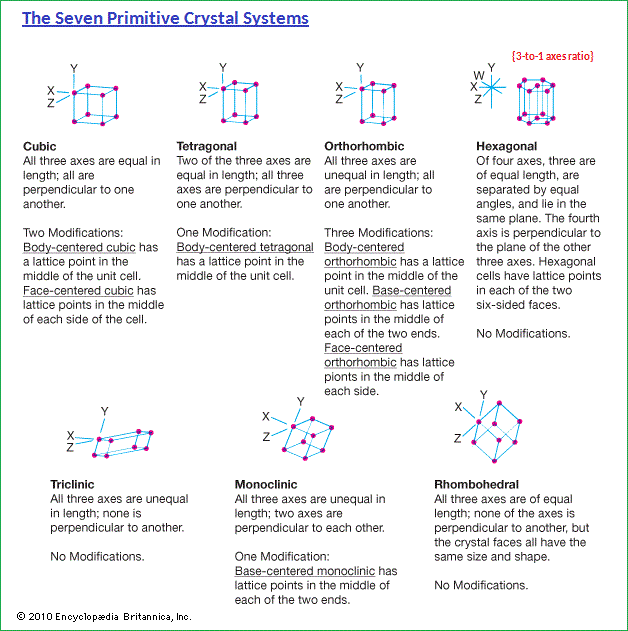
No less, if we recall the claim that both DNA and RNA have triplet coding systems, when we put them together we can denote a 3-to-1 configuration as well:
| ~ Item ~ | ~ Three the same ~ | ~ One is different ~ |
| DNA = | Adenosine- Cytosine- Guanine | Thymine |
| RNA = | Uracil |
We are not trying to say that people can't think in larger or more complex patterns, it is just that the conventions of thinking we do use appear to be a reflection of environmental pressures which are headed along a path of decay towards extinction. Not only is this important for a discussion involving Peace, but all our philosophies, religious beliefs and government practices.
(We're still warming up for this journey)
Date of Origination: Wednesday, 14-Dec-2016... 03:08 AM
Date of initial posting: Wednesday, 14-Dec-2016... 10:39 AM
Updated Posting: Friday, 20th April 2018... 5:50 AM


